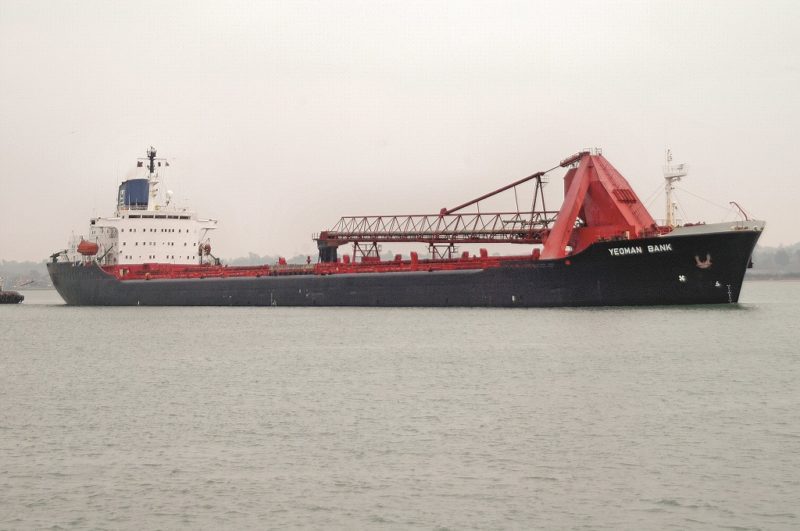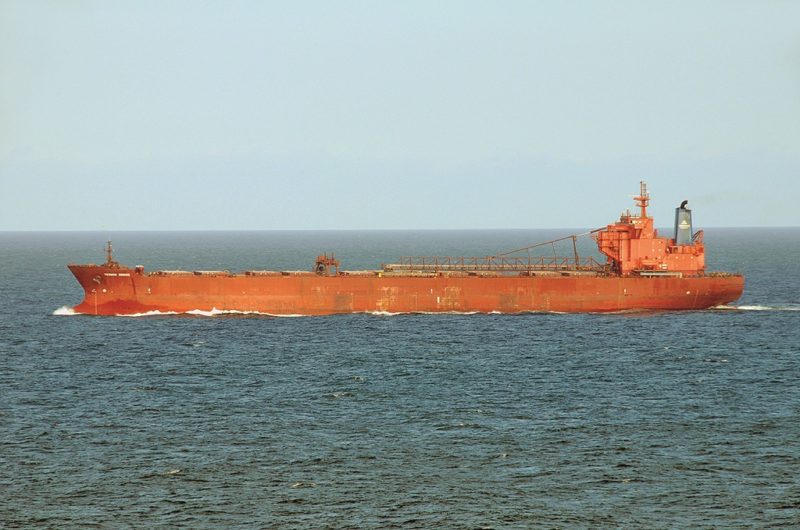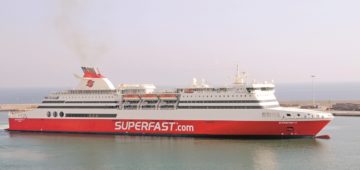
Anyone who frequents the shores or waters of the Western Isles of Scotland will invariably have seen the silhouette of the self-unloading bulk carriers owned by Aggregate Industries U.K. Ltd. Their three ships are regular visitors to the isolated port of Glensanda on the Morvern Peninsular.
The smallest of the trio is the 24,879 gt Yeoman Bank which was also the last bulk carrier built for Ropners, although further second hand vessels, Oakby and Deerpool, featured in the fleet until the company ceased trading in 1997 after being taken over by J.I. Jacobs. The ship, named Salmonpool, became the third vessel of the company to carry the name, being laid down on the 1st September 1974 at the Eleusis Shipyard in Greece for a local owner. However completion was delayed pending an upturn in the freight market and the ship remained unfinished until bought by Ropner at a discounted price whilst still on the stocks,.
Salmonpool (1) was completed in 1913 by Ropner & Sons Ltd., of Stockton on Tees. She had a gross tonnage of 4,905 and a deadweight of 8,660 tons. The vessel was sunk on the 1st June 1916 by German U-boat U-39 off Tunis whilst on a voyage in ballast to the USA. Her master, Captain J.E. Jones and the entire crew landed safely in Tunis. U-39 was sunk in the English Channel on the 17th May 1917 by the Royal Navy ‘Q’ Ship Glen, which was an auxiliary schooner.
Salmonpool (2) was completed in 1924 by Irvine’s Ship Building and Dry Dock Co. at Hartlepool, and was the last ship to be completed by that company. The vessel was built from plans originating from 1914 and looked somewhat of an oddity with a very thin, tall funnel. The vessel had a gross tonnage of 4,928 with deadweight of 8,570 tons.
She had a length of 390 feet and beam of 55 feet and was powered by coal fired triple expansion steam engines.
Salmonpool was captured on the 15th May 1940 at Saude, Norway having just completed discharging a cargo of coke. The ship, under the command of Captain C. Yare, made an attempt to escape but the vessel was intercepted and captured, all of the crew being made prisoners of war in Germany.
Taken over by the Germans and renamed Putzig, the vessel was used in the ore trade from Lulea to German Baltic ports. Following the end of the war the ship was taken over by the Ministry of War Transport and arrived at Methil on the 20th November 1945, being renamed Empire Salmonpool. She was, again, placed under Ropner management.
Empire Salmonpool was moved to dry dock in Hull, where she remained for 4/5 weeks for boiler and furnace repairs plus refurbishment to her accommodation. Her first voyage under Ropner management was from Hull to Takoradi on the 5th March 1946 to load for the USA.
The ship was sold to N.G. Kyriakides Shipping Co. Ltd., (Winchester Shipping Co. Ltd.) being handed over on the 21st February 1947 and renamed Irene K. She became White Lodge in 1955, then Puntarenas later the same year. She was scrapped at Aviles in Spain in 1958. In 1955 the Winchester Shipping Co. Ltd., bought another Ropner vessel, ss Firby (ex Ocean Fame) again, renaming her Irene K.
Salmonpool (3) replaced Stonepool, which was sold to owners in Hong Kong in 1982 without change of name. Stonepool was the first of the larger bulk carriers built for the company entering service in 1966. Charles Connell & Co. Glasgow built the vessel (yard no 10011) and she had a gross tonnage of 27,049 with deadweight of 45,027 tons. The ship ended her days in 1986 arriving at Kaohsiung on the 4th September of that year for scrap.
Miss Sophie Ropner, daughter of Mr. Jeremy V. Ropner, a director of the firm launched Salmonpool on the 18th June 1981 and the ship entered service on the 25th May 1982.
Built as a 1A1 gearless bulk carrier, Salmonpool had a gross tonnage of 24,870, a net tonnage of 15,182 and deadweight of 43,728 tons. Her dimensions were 204.95 m x 27.26 m and a laden draught of 11.79 m. The vessel was powered by a two stroke six cylinder 6RD90 Sulzer Diesel engine built under licence by Sumitomo Heavy Industries. The engine produced 14,200 BHP (9415 kw) giving a service speed of 15.5 knots. A bow thruster unit was also fitted producing 1,100 kW of power.
Salmonpool was a difficult ship to charter. A former second mate recalls how the company contracted personnel from the ship were aware that she could be sold at any time. After paying off, as they drove away in the coaches provided by the company, they wondered if they would ever see the vessel again.
The ship spent sometime laid up on the Clyde and in 1988 her port of registry was changed from the usual Hartlepool to Nassau when she hoisted the Bahamas flag. Salmonpool was sold in July 1990 after only 8 years service wearing the distinctive green hull with red and white check on a green funnel, which identified a Ropner ship throughout the world.
Salmonpool was renamed Yeoman Bank when purchased by K/S Fernbank (K/S Glensanda, Oslo) with managers Fearnley and Eger and registered in Oslo.

In January 1991 she completed conversion to a ‘self unloader’ by Artctos Framnaus, Norway and commenced trading in her new role. However, Fearnley and Eger went out of business in 1991 and on the 5th February 1992 the vessel changed managers when she was delivered into a bareboat charter to Egon Oldendorff (Liberia) Inc., via Foster Yeoman UK, now Aggregate Industries.
Her conversion involved the fitting of a large self-unloading discharge boom near the forecastle of the ship. A tunnel conveyor belt on the bottom of the holds fed this, and by swinging out the boom over either side of the ship her cargo could be discharged ashore, or into the hold of another ship alongside. The boom outreach measures 56.5m with a discharge rate of up to 3,500 tonnes per hour. Following conversion her summer deadweight is now 38,997 tonnes and winter deadweight of 37,856 tonnes. The vessel has seven holds with hatches all 9.6m x 12.64m.
Egon Oldendorff continued to manage Yeoman Bank on behalf of Foster Yeoman Ltd., until V. Ships (UK) took over in 2003 operating from the Glasgow office. Aggregate Industries, part of the Holcim Group, acquired Foster Yeoman in 2006 and the ship was given her distinctive funnel colours of blue with a white triangle with “Yeoman, Glensanda” painted below.
Crewing of Yeoman Bank continues to by managed by V. Ships (UK) Glasgow although Aggregate Industries Shipping Office, which is situated in Frome, Somerset conducts voyages/cargo arrangements. The ship carries a Ukrainian crew, currently consisting of 6 officers and 24 ratings. She is registered in Monrovia and flies the Liberian flag. Her call sign is ELOG5 and IMO number 7422881.
The vessel along with the two other ships in the fleet, Yeoman Bridge and Yeoman Bontrup, regularly operate from the isolated port of Glensanda, which can only be reached from the sea, having no road or rail links.
Glensanda is situated off the Western Isles of Scotland on the Morvern Peninsular overlooking the Isle of Lismore and Loch Linnhe. Situated here is the Glensanda Super Quarry owned by Foster Yeoman/Aggregate Industries and up to 6 million tonnes of granite aggregates are quarried and shipped annually. There are estimates of reserves of granite for up to 100 more years.
From the jetty beside the quarry on Loch Linnhe, Yeoman Bank completes 40-50 voyages per year, mostly in North West Europe and to Garrucha in Spain.

On the 20/21st March 2014 Yeoman Bank completed her 1,000th voyage for her owners. A commemorative booklet was produced by Aggregate Industries and records that from her first voyage for the company on the 23rd January 1991 she had carried enough gypsum to make 467,712 sq. km. of plasterboard, enough to cover the UK twice, 25.9 million tonnes of aggregate, 5.8 million tonnes of gypsum, 1.9 million tonnes of coal and 1.3 million tonnes of iron ore. Other cargoes made up 0.12 million tons, an impressive record.
The owners of the Yeoman fleet have a target of 40 years of service for their vessels and in December 2008 Yeoman Bank entered the Lisnave Shipyard in Portugal for a major dry dock period. A large quantity of the steel in the holds was replaced due to coating failure and corrosion, caused by the continuous carriage of harsh, bulk cargoes. The holds were blasted and then coated with a protective ‘Vessgard’ substance. The order of work was holds 1, 5, 2, 6, 3, 7 and 4 so that at no point would blast and coating take place in holds adjacent to each other.
During September 2010 Yeoman Bank underwent a further extensive maintenance period in a floating dock at Gdansk when the hull above and below the waterline was completely repainted and maintenance and repairs carried out on the self-unloading equipment. A further dry dock period took place at the A & P Shipyard in Falmouth in September 2014 and another major dry dock period in 2016.
Yeoman Bank arrived at the KS Terminals of the Freeport of Riga, Latvia, with 33,000 tonnes of crushed granite, for the first time on the 10th May 2012. This heralded the launch of operations by Yeoman Latvia, a subsidiary of the UK based company.
The other two other vessels currently in the Yeoman fleet are Yeoman Bontrup IMO 8912297 (ex Western Bridge) and Yeoman Bridge IMO 8912302 (ex Eastern Bridge). They are the largest self-unloading bulk carriers in the world at 96,772 tonnes deadweight each. Both entered service in 1991 owned by British Steel, and initially managed by Ropner/J.I. Jacobs, until being sold to Yeoman in September 2002 and May 2000 respectively. Following their acquisition they were fitted with self-unloading equipment, which can discharge up to 6,000 tonnes per hour.
Both ships were completed by Tsuneishi Tadotsu, Japan and each has a gross tonnage of 55,695 and deadweight of 96,772 tonnes. Dimensions of the two ships are 250 x 38 x 13.8m. 1 Kawasaki MAN/B&W 6870 6 cylinder diesel gives the ships a speed of about 15 knots. Their management history is similar to that of Yeoman Bank, following their sale by British Steel to Yeoman.
Yeoman Bank will complete 40 years of service this year, She remains a credit to her owners who continue to maintain this old lady in excellent condition.




Comments
Sorry, comments are closed for this item